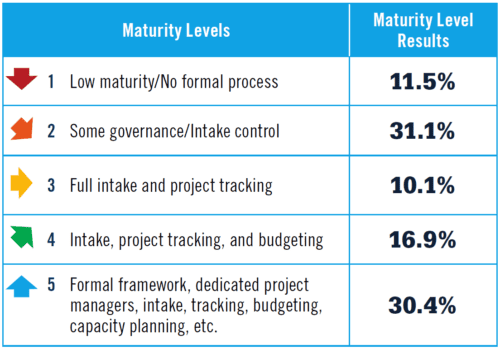Avoid the Heavy Cost of Low Project Management Maturity
Measuring Project Management Maturity
“Stop being so immature!” might have been something you were told as a kid. And while you likely rolled your eyes and muttered “whatever…” under your breath at the time, you probably didn’t realize that immaturity can still be an issue in your professional life—except we’re not talking about cracking jokes during meetings or pranking your colleagues. Instead, what we’re talking about here are the impacts low project management maturity can have on your organization. In a recent market study conducted by ProjectManagement.com, an encouraging 30.4% of participants reported being at level 5, while a worrying 42.6% indicated that their organizations were operating at level 1 or 2.
Low to High Maturity Differences
That’s all fine and good, but if you’re wondering what the real differences between the opposite ends of the project management maturity scale are, it’s simple. Organizations at the top end of the scale are consistently delivering projects successfully, and those on the lower end of the scale are likely struggling to do so.
That may sound overly simplistic, but these struggles lead to tangible outcomes that can have potentially detrimental effects on an organization. We asked what percentage of projects achieved business goals and the average response showed that only 7.4% reported less than 50% of their projects succeeded, which is encouraging. However, what we also found is that based on that same metric, organizations at levels 1 and 2 were six and a half times more likely (14.3%) to have more than half of their projects fail versus a mere 2.2% of level 5 organizations. Just let that sink in for a moment—six and a half times more likely to have more than half of their projects fail. Wow.
Another area of focus was benchmarking how successful organizations are when it comes to keeping their projects on schedule and on budget—specifically at a rate of 70% of the time or greater. On average, respondents reported more success with keeping projects on budget (52.7%) than on schedule (41.9%), but when we looked at the high and low ends of the scale, we found that level 5 organizations were at least twice as likely to achieve these project outcomes than level 1 and 2 level organizations. So, while these metrics are certainly interesting—and perhaps even startling, we still wanted to get to the bottom of why this is the case.
Project Governance
What we found is that project governance (or lack thereof) seemed to be the main predictor of project success or failure. And within that sphere, the areas that showed some of the widest gaps were resource capacity planning, formal project intake/governance reviews, and the existence of a formal project management office (PMO). But fear not—becoming a level 5 organization does not need to be the goal here. For many organizations, the focus should simply be on improvement—and that is very much within reach with the right amounts of information, effort, and commitment.
